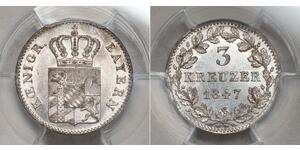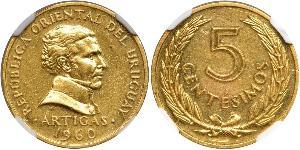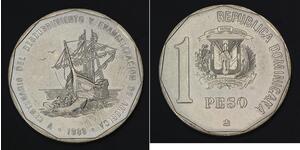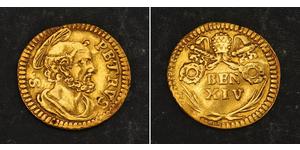(sold for $5.0)
1860s, Austria. Copper "Emperor Ferdinand & Moravian-Silesian North Railway" 1 Heller Token Coin. R!
Mint Year: 1860s Mint Place: Vienna Reference: Heisler 36/1. Condition: Minimal dark deposits, otherwise a nice UNCirculated token with much original mint luster and crisp details! Denomination: Consumation Token Coin of 1 Heller (Geldersatzmarke über 1 Heller für Konsumgüter) for the Emperor Ferdinand & Moravian-Silesian Northern Railway between Vienna and Prague. Material: Copper Diameter: 18mm Weight: 2.32gm
Obverse: Large value numeral (1) above winged railway wheel. Legend: K.F.U.M.SCH.NORDBAHN ("Kaiser Ferdinand und Mährisch-Schlesische Nordbahn") Reverse: Large value numeral (1) above winged railway wheel. Legend: K.F.U.M.SCH.NORDBAHN ("Kaiser Ferdinand und Mährisch-Schlesische Nordbahn")
The Emperor Ferdinand Northern Railway (German: Kaiser Ferdinands-Nordbahn; Czech: Severní dráha císaře Ferdinanda; Polish: Kolej Północna Cesarza Ferdynanda) was the name of a former railway company during the time of the Austrian Empire. Its main line was intended to connect Vienna with the salt mines in Bochnia near Kraków (Krakau). The term is still used today in referring to a number of railway lines formerly operated by that company.
The Nordbahn, financed by Salomon Mayer von Rothschild (1774–1855), was Austria's first steam railway company. The first stretch, between Floridsdorf and Deutsch Wagram, was opened in 1837. An extension to Vienna was built in 1838, and the track through Břeclav (Lundenburg) to Brno (Brünn) in 1839. The first train from Vienna arrived in Břeclav railway station on 6 June 1839. By 1841 the railway had reached Přerov (Prerau) and Olomouc (Olmütz) and in 1842 Lipník nad Bečvou (Leipnik). An extension to Ostrava (Ostrau) and Bohumín (Oderberg) was completed in 1847.
The Nordbahn never directly reached Kraków or Bochnia. The first rail connection to Kraków via Bohumin, Kozle (Kosel), and Mysłowice (Myslowitz) was provided by the Prussian Wilhelmsbahn and Oberschlesische Eisenbahn (Upper Silesian Railway). The line from Mysłowice to Kraków was built by the Krakau-Oberschlesische Bahn (Krákow and Upper Silesian Railway). An entirely Austrian rail route from Vienna to Kraków did not exist until, in 1856, the k.k. Östliche Staatsbahn (Imperial and Royal Eastern State Railway), a descendant of the Krákow and Upper Silesian, opened a branch form Trzebinia via Oświęcim (Auschwitz) to Czechowice-Dziedzice (Czechowitz-Dzieditz), where it met the Northern Railway.
The Northern Railway company was nationalized in 1907. It also owned many coal mines and other industry enterprises in the Ostrava region. After the nationalization of its railway network, the company continued to operate its coal and industry businesses.
The original Nordbahnhof in the Austrian capital (Vienna North railway station) was destroyed in World War II. It was rebuilt and re-opened in 1962 as Wien Praterstern together with the bridge across the Danube. Today's express trains from Vienna to Brno now leave from Wien Meidling railway station, and Praterstern is served by suburban and regional trains only.
Ferdinand I, Emperor of Austria, King of Hungary and Bohemia (April 19, 1793 – June 29, 1875) succeeded his father (Franz II Holy Roman Emperor/Franz I of Austria) as emperor and king (as Ferdinand V) in 1835. He chose to abdicate, after a series of revolts in 1848. He was also King of Lombardy-Venetia.
Ferdinand has been depicted as feeble-minded and incapable of ruling, but although he was epileptic and certainly not intelligent, he kept a coherent and legible diary and has even been said to have a sharp wit. The up to twenty seizures he had per day, though, severely restricted his ability to rule with any effectiveness.
Though he was not declared incapacitated, a regent's council (Archduke Luis, Count Kolowrat and Prince Metternich) steered the government. His marriage to Princess Maria Anna of Sardinia (1803-1884) was probably never consummated, nor is he believed to have had any other liaisons. He is famous for his one coherent command: when his cook told him he could not have apricot dumplings because they were out of season, he said "I'm the Emperor, and I want dumplings!" (German: Ich bin der Kaiser und ich will Knödel.)
As the revolutionaries of 1848 were marching on the palace, he is supposed to have asked Metternich for an explanation. When Metternich answered that they were making a revolution, Ferdinand is supposed to have said "But are they allowed to do that?" (Viennese German: Ja, dürfen's denn des?) He was convinced by Felix zu Schwarzenberg to abdicate in favour of his nephew, Franz Joseph (the next in line was Ferdinand's younger brother Franz Karl, but he was persuaded to waive his succession rights in favour of his son) who would occupy the Austrian throne for the next sixty-eight years.
Ferdinand recorded the events in his diary : "The affair ended with the new Emperor kneeling before his old Emperor and Lord, that is to say, me, and asking for a blessing, which I gave him, laying both hands on his head and making the sign of the Holy Cross ... then I embraced him and kissed our new master, and then we went to our room. Afterward I and my dear wife heard Holy Mass ... After that I and my dear wife packed our bags"
Ferdinand was the last King of Bohemia to be crowned as such. Due to his sympathy with Bohemia (where he spent the rest of his life in Prague Castle) he was given the Czech nickname "Ferdinand V, the Good" (Ferdinand Dobrotivý). In Austria, Ferdinand was similarly nicknamed "Ferdinand der Gütige" (Ferdinand the Benign), but also ridiculed as "Gütinand der Fertige" (Goodinand the Finished).
He is interred in tomb number 62 in the Imperial Crypt in Vienna.

|
Posted by:
anonymous 2021-03-24 |
1 Peso Dominican Republic Copper/Nickel
group has 3 coins / 3 prices
⇑
1/2 Scudo Vatican Gold
group has 5 coins / 5 prices
⇑
























